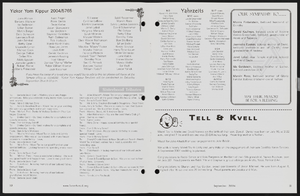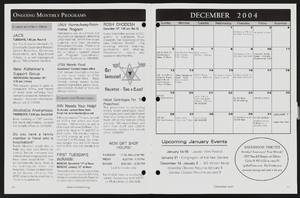Search the Special Collections and Archives Portal
Search Results

Transcript of interview with Liliam Lujan Hickey by Layne Karafantis, March 18, 2010, & March 25, 2010
Date
Archival Collection
Description
Liliam Lujan Hickey is best known in the state of Nevada for being the first Hispanic woman elected to the State Board of Education as well as for the enormous contributions she made while serving from 1998 to 2000. For this, an elementary school in Clark County bears her name. Despite many obstacles, Liliam has continually dedicated herself to standing up for the causes she believes in, such as providing preschool education to the underprivileged, preparing youth to enter the workforce, helping other Hispanics run for office, and proving that with enough courage anyone can accomplish their dreams. Born in Havana, Cuba in 1932, Liliam led a sheltered life that revolved mostly around her studies at a French Dominican school. She met her first husband, Enrique Lujan, when she was only sixteen and they wed soon after. Enrique was twelve years her senior, owned many casinos on the island, and provided a luxurious existence for Liliam and their three children. However, this lifestyle abruptly changed when Castro assumed power in 1959 and Liliam and her family were compelled to relocate to the United States. In Miami, Enrique assisted other refugees financially, hoping that his wealth would remain secure in Cuba. He was wrong. This left the family destitute. In addition to casinos, Enrique had been Cuba?s coach for the Olympics. He moved the family to York, Pennsylvania, where he hoped to find work at the York Barbell Company. Liliam, who had been accustomed to having maids and nannies in Cuba, found herself doing all the housework while she also worked in a factory. The change could not have been more dramatic and the living conditions became unbearable. The family chose to move to San Diego in a Volkswagen Minivan with the hope for a better life. The next few years brought many transitions. Things did turn around in San Diego, and Liliam she recalls her years in southern California as some of the happiest of her life. Liliam found a job working at the Scripps Clinic in La Jolla. After a few years, Enrique found a job in Las Vegas and the family moved again. In Las Vegas, Liliam gave birth to her fourth child, Mary, and life once again became financially difficult for the family. In 1972, the situation grew worse with Enrique?s untimely death. Liliam was a widow at forty years of age. She had to teach herself how to drive a car, write checks, and perform financial tasks that Enrique had insisted on managing while he was alive. Determined not to give up, however, she worked tirelessly to keep the family together. Amidst all this, a friend introduced Liliam to Tom Hickey, and after a brief courtship they were married in 1981. Within a few years, Liliam became active in politics, running for the State Board of Education. Her campaign manager advised her that voters would not be receptive to photos of a Hispanic woman on billboards, and to capitalize on the name “Hickey,” which was a recognizable name because her husband was an assemblyman. She took the manager?s advice and was elected in that campaign and for two more terms, the maximum limit for the office. After the first race, she proudly displayed her face on billboards across the state. During her time at the State Board of Education, Liliam dedicated herself to helping all children receive a better education in Nevada, not only Hispanics. She co-founded the Classroom on Wheels [COW] program, which brought buses to poor neighborhoods to provide pre-school education. She established Career Day, which pairs high schools students with business professionals in an effort to help them make the transition into the workforce. While the COW program is no longer running, 8 Career Day still operates and awards scholarships in Liliam?s name annually, which helps youth receive the educational opportunities they need to succeed. And she involved Hispanic youth in Boy Scouts by bringing ScoutReach to the Las Vegas valley. Lujan Hickey worked in a wide array of other community organizations. In the 1970s, she began to work with Circulo Cubano, which later became the Latin Chamber of Commerce, and she would later belong to the National Chamber of Commerce. A longstanding member of the League of Women Voters, Liliam saw the need to get Hispanics more involved in politics in the state. Her story is one of great inspiration, and when asked why she does it, she simply replies with a smile, “I love life.” Hickey?s narrative offers the reader a glimpse of the experiences of the Cuban refugee experience in the U.S. in general. Specific to Las Vegas, it provides a rare story of the experiences of early Latinas in the political and economic development of Las Vegas in the last half of the twentieth century.
Text

Transcript of interview with Nancy Houssels by Caryll Batt Dziedziak, November 18 & December 14, 1998
Date
Archival Collection
Description
What is the importance of dance? For Nancy Claire Houssels, it has simply shaped her life! Born on February 26, 1935 to Edith Darlene Wallace and William Edwin Wallace, Nancy grew up with three brothers in an athletic household in Piedmont, California. She began dancing at the early age of three and filled her childhood years with dance and synchronized swimming. After attaining a Bachelor of Arts Degree in Theatre Arts from UCLA in 1957, Nancy went on the road with the Hollywood Bowl; soon meeting her future dance partner, Francois Szony. Already known as one of the most respected adagio dancers in the world, Szony would become Nancy’s dance partner for the next ten years. The Szony and Claire adagio team rehearsed in New York City before heading off to their first European engagement at the London Palladium. The team spent the next few years appearing in London, Copenhagen, Paris, Vienna, Rome, Turino, Milan, Barcelona, and even Beirut. Their physical ability to perform breath-taking spins and lifts appealed to broad audiences; even those with little or no appreciation of ballet. After returning to the states, Szony and Claire performed in Miami, Puerto Rico, and throughout New York; including Radio City Music Hall, the Ed Sullivan Show, Carnegie Hall, and Madison Square Garden. In 1966, the dance team headed to Las Vegas, Nevada to appear with the Casino de Paris at the Dunes Hotel. Shortly thereafter, in 1968, Szony and Claire joined the cast of the Folies Bergere at the Tropicana Hotel. In May 1970, Nancy married J. Kell Houssels, Jr., then the President of the Tropicana Hotel. As Nancy likes to retell this moment, “Well, my husband fired me and we got married!” After more than thirty years of dancing, Nancy felt ready to end her professional dance career and looked forward to starting a family. Nancy and Kell subsequently had two children: Kelly Clair and Eric Wallace, and Nancy happily ‘inherited’ three stepchildren: Josh, Jake, and Leslie. The adjustment of shifting from a career characterized by a grueling work schedule to that of domestic life proved challenging for Nancy. She soon began looking for ways to involve herself in the community. Since the early 1970s, Nancy has lent her time and support to such diverse entities as Child Haven, Children’s Service Guild of the Clark County Juvenile Court System, National Conference of Christians and Jews, PBS Friends of Channel 10, Nathan Adelson Hospice, Meadows School, United Campus Ministry, Las Vegas Metropolitan Beautification Committee, McCarran Airport Arts Advisory Committee and the University of Nevada, Las Vegas Foundation. While Chair of the Nevada State Council of the Arts for seven years, she proved instrumental in establishing a Folk Arts program and expanding legislative funding for statewide arts programs. Nancy’s service to the community has been recognized with such awards as the 1985 Nevada Dance Theatre’s Woman of the Year, the 1988 Governor’s Arts Award - Distinguished Service to the Arts, the 1994 State of Nevada’s Women of Achievement, and the 1997 We Can, Inc.’s Chris Schaller Award for children’s advocacy. Although her days as a professional dancer had ended, Nancy never relinquished her love of dance. In 1972, Nancy joined Vassili Sulich in founding the Nevada Dance Theatre. As the principal dancer in the Folies Bergere, Sulich had organized a series of dance concerts for the Las Vegas community. Much to Nancy’s surprise, the Las Vegas community responded enthusiastically to the availability of ballet performances. Nancy quickly formed a volunteer board to raise the critically needed funding for this endeavor. She began with an evening fundraiser at her home, inviting a group of like-minded friends. This effort raised the initial fifteen thousand dollars that set the Nevada Dance Theatre on its way. In 1976, the company acquired its non-profit status and subsequently formed an academy to train children in dance. Nancy played an instrumental role in furthering the ballet company’s community outreach; creating such programs as Future Dance funded by the Lied Foundation. This program targets lower income children who attend at-risk elementary schools and provides them with free dance instruction…building self-esteem, confidence, and hope. In 1996, with a capital grant from the Donald W. Reynolds Foundation and land donated by the Howard Hughes Corporation, the Nevada Dance Theatre began drawing their plans for a world-class facility in Summerlin. Completed in 1999, the company now had a visible home within the Las Vegas community. Here, students from the Las Vegas community trained alongside the company’s professional dancers. Renamed in 1998 as the Nevada Ballet Theatre and with a new Artistic Director, Bruce Steivel, the Company continues to serve not only as a leading force for live performing arts, but also as a source of community outreach programs for children. Nancy continues to remain involved with the Nevada Ballet Theatre and currently serves as the Co-Chair of the Company. She believes her life experience reflects both the viewpoint of the artist and that of the audience. Indeed, her visionary leadership and love of dance has not only shaped her life but has nurtured the development of the cultural arts in Southern Nevada.
Text

Transcript of interview with Rita Deanin Abbey by Claytee White, November 29, 2014 and February 26, 2015
Date
Archival Collection
Description
Rita Deanin Abbey is an Emeritus Professor of Art at the University of Nevada, Las Vegas. She taught drawing, painting, and color theory and innovated interdisciplinary courses with the sciences at UNLV from 1965 to 1987. The University of Nevada, Las Vegas, Marjorie Barrick Museum and the Palm Springs Desert Museum (presently Palm Springs Art Museum), Palm Springs, CA collaborated to present the Rita Deanin Abbey 35 Year Retrospective, which was held February 16-March 5,1988 at UNLV and March 25-June 5,1988 at the Palm Springs Art Museum. Abbey received her Bachelor of Fine Arts degree in 1952 and her Master of Arts degree in 1954 from the University of New Mexico, Albuquerque, NM. She also studied at Goddard College, Plainfield, VT; the Art Student s League, Woodstock, NY; the Fians Hofmann School of Fine Arts, Provincetown, MA; and the San Francisco Art Institute, San Francisco, CA. She was an artist in residence in the studios of Toshi Yoshida, Tokyo, Japan, John Killmaster, Boise, ID; Methow Iron Works, Twisp, WA; Tamarind Institute, University of New Mexico, Albuquerque, NM; the Mason Gross School of the Arts, Rutgers, The State University of New Jersey, New Brunswick, NJ; Shidoni Foundry, Tesuque, NM; Bill Weaver Studio, Chupadero, NM; Savoy Studios, Portland, OR; and Carlson & Co., San Fernando, CA. Abbey, who works in the areas of painting, drawing, printmaking, sculpture, porcelain enamel fired on steel, stained-glass, and computer art, has had 60 individual exhibitions and has participated in over 200 national and international group exhibitions. She is represented in private and public collections in the United States, the Middle East, Europe, and South America. Abbey has published several articles in journals, and six books: Rivertrip, Northland Press, Flagstaff, AZ, 1977; Art and Geology: Expressive Aspects of the Desert, Peregrine Smith Books, Layton, UT, 1986 (co-authored by G. William Fiero); the Rita Deanin Abbey Rio Grande Series, Gan Or, Las Vegas, NV, 1996; In Praise of Bristlecone Pines, The Artists' Press, Johannesburg (presently located in White River), South Africa, 2000; Isaiah Stained- Glass Windows, Gan Or, Las Vegas, NV, 2002; Seeds Yet Ever Secret, Poems and Images, Gan Or, Las Vegas, NV, 2013. She has been the recipient of many commissions and grants and has won several awards, including the Bicentennial Commission for the State of Nevada, 1976; the Governor's Seventh Annual Visual Arts Award for the State of Nevada, 1986; and the Chairman's Award of Excellence at the 1987 International Exhibition of Enamelling Art, Ueno Royal Museum, Tokyo, Japan. From 1988-1990, Abbey fabricated Northwind, a steel sculpture (17ft. x 27 ft. 5 in. x 25 ft. 10 in., 7 tons), installed in Las Vegas, NV. Abbey was invited by the Gallery Association of New York State to exhibit four of her works in its 1989-1991 traveling exhibition, Color and Image: Recent American Enamels. In 1992, the Markus Galleries, Las Vegas, NV, and the Nevada Symphony presented an exhibition of art by Abbey, which inspired Virko Baley s Piano Concerto No. 1. The world premiere performance of the concerto was held in 1993 at the National Opera House, Kiev, Ukraine. In 1993, Abbey constructed Spirit Tower, a cor-ten steel sculpture (20 ft., 11 tons), which was commissioned by the Las Vegas-Clark County Library District for the Summerlin Library and Performing Arts Center. Abbey was invited by the Pacific Division of the American Association for the Advancement of Science to lecture on Art and Geology at San Francisco State University for the 75th Annual Meeting, on June 19-24,1994. She was one of three artists from the United States invited to participate in the exhibition, Enamel Today, at Villa am Aabach, Uster, Switzerland, June-July, 1995. Additionally in 1995, Abbey completed a series of cast bronze sculptures at Shidoni Foundry, Tesuque, New Mexico. Commissioned in 1998, Abbey completed the Isaiah Stained-Glass Windows in 2000, sixteen 10 ft. x 2 ft. stained-glass windows for the main sanctuary of Temple Beth Sholom, Las Vegas, NV. Also in 2000, she completed Holocaust, a stainless steel sculpture (14 ft. 3 in., 4.5 tons), installed in Las Vegas, NV. In 2003 her bronze sculpture, Ner Tamid, was installed in Temple Adat Ami, Las Vegas, NV. Snakewash, a cor-ten steel ground sculpture (62 ft.), was completed in November 2003. Abbey fabricated steel sculptures and cast small and large bronzes from 2004 through the present. In 2006 she completed and installed Guardian of All Directions, a stainless steel sculpture (14 ft., 1.5 tons). The Guggenheim Hermitage Museum and Young Collectors Council visited the studio and home of Rita Deanin Abbey, Las Vegas, Nevada October 15, 2006. During March 2008, Women's History Month, Abbey was recognized for her contributions to the Arts by Mayor Goodman and Members of the Las Vegas City Council. Hidden Pass, a 2-inch steel plate sculpture (16 x 28 ft. 8 in. x 13 ft., 22 tons), was installed in 2010. Between July 16-December 23, 2011, Abbey exhibited in Blast from the Past, '60s & '70s Geometric Abstraction at Palm Springs Art Museum, Palm Springs, California. The City of Las Vegas Office of Cultural Affairs, Las Vegas Arts Commission presented Abbey the Lifetime Achievement Award for Excellence in the Arts on May 25, 2012. Balanced Arc, an outdoor bronze sculpture (8ft. 8 in. x 9 ft. x 7 ft. 4 in., 1600 lbs.), completed in 2012, was installed in April 2013. The Western Museums Association 2014 Annual Meeting in Las Vegas, NV, toured The Art of Rita Deanin Abbey at the Desert Space Museum October 5, 2014. Abbey participated in the fall group exhibition Macrocosm/Microcosm: Abstract Expressionism in the American Southwest at the Fred Jones Jr. Museum of Art, University of Oklahoma, Norman, Oklahoma, October 2, 2014-January 4, 2015. Her artwork was also shown in the Recent Acquisitions exhibition at the Marjorie Barrick Museum, University of Nevada, Las Vegas, June 19-September 19, 2015. Currently, Abbey is working on new sculptures, paintings, and enamels. vii
Text
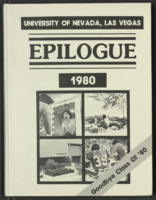
Epilogue: UNLV Yearbook, 1980
Date
Description
Yearbook main highlights: schools and departments; detailed lists with names and headshots of faculty, administration and students; variety of photos from activities, festivals, campus life, and buildings; campus organizations such as sororities, fraternities and councils; beauty contest winners; college sports and featured athletes; and printed advertisements of local businesses; Institution name: University of Nevada, Las Vegas
Mixed Content
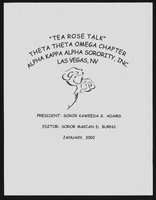
Alpha Kappa Alpha Sorority, Theta Theta Omega Chapter "Tea Rose Talk" newsletters
Date
Archival Collection
Description
From the Alpha Kappa Alpha Sorority, Incorporated, Theta Theta Omega Chapter Records (MS-01014) -- Chapter records file.
Text

Jessica Hutchings oral history interview: transcript
Date
Archival Collection
Description
Oral history interview with Jessica Hutchings conducted by Barbara Tabach on March 21, 2018 for the Remembering 1 October Oral History Project. In this interview, Jessica Hutchings discusses her experience flying to Las Vegas, Nevada on the night of the October 1, 2017 mass shooting. She speaks of her flight's detour to Phoenix, Arizona, and her discovery of the shooting. Hutchings explains how Congregation Ner Tamid, where she is a cantor, contributed to the community healing after the tragedy, including their organization of vigils, a music fundraiser called "Vegas Strong in Song," and discussing the event with teenage Hebrew School students who had questions and concerns about the shooting.
Text
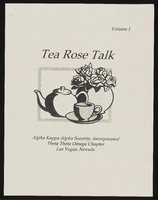
Alpha Kappa Alpha Sorority, Theta Theta Omega Chapter "Tea Rose Talk" newsletters
Date
Archival Collection
Description
From the Alpha Kappa Alpha Sorority, Incorporated, Theta Theta Omega Chapter Records (MS-01014) -- Chapter records file.
Text
Brenda Pearson (Clark County Education Association) oral history interview conducted by Magdalena Martinez and Peter Grema: transcript
Date
Archival Collection
Description
From the Lincy Institute "Perspectives from the COVID-19 Pandemic" Oral History Project (MS-01178) -- Education sector interviews file.
Text

